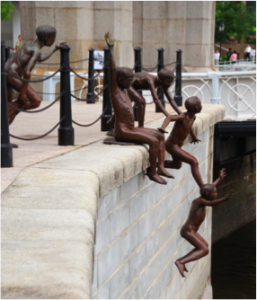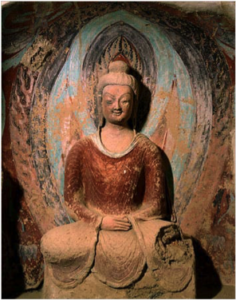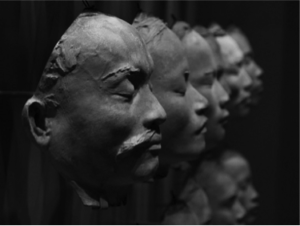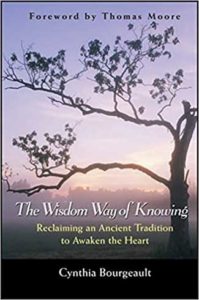See below this reflection for the Spanish translation.

In our own engagement with Wisdom, we continue to return again and again to this book and to this particular chapter, “Chapter 3: Three Centered Knowing.”
This chapter lays out for us the how of being more fully present and open to higher meaning and the physiology of transformation. Since human beings are “three brained” or “three centered”, this teaching is foundational to spiritual transformation as we seek to know with more of ourselves online and available. We usually have one center we rely on or have a natural affinity towards. The inner tradition practices invite us to cultivate our “blind” or under-used centers with the intention of integrating and balancing all three. Cynthia says:
When a person is poised in all three centers, balanced and alertly there, a shift happens in consciousness. Rather than being trapped in our usual mind, with its well-formed rut tracks of issues and agendas and ways of thinking, we seem to come from a deeper, steadier, and quieter place. We are present, in the word of Wisdom tradition, fully occupying the now in which we find ourselves. (p.36)

Cynthia lays out how each of the centers function beginning with the moving center which relates to our embodiment. She describes two subsets of the moving center: instinctive and the moving center proper. The instinctive subset is like our hard drive and it operates all the systems of our bodies (breathing, digestion etc..). The moving center proper is like our software and it operates our interface with the outward world as we engage through movement, gesture, rhythm, and our five senses. Our relationship with our moving center begins with befriending our bodies and recognizing the perceptivity, guidance and capacity inherent there. Our body prayers, work with sensation and sacred dances all deepen our relationship with this center. We are invited to fully inhabit our bodies.

Cynthia is clear, as she explains the emotional center, that she is not talking about the seat of our personal affective life. She distinguishes the emotional center from the heart as described in the ancient sacred traditions. “Growing up the heart” involves working skillfully with emotions and nervous system regulation, and ultimately it is our “antenna” for perceiving divine energy, purpose and connection. The emotional center is an organ for spiritual perception, “a bridge between our mind and our body and also between our usual physical world and this invisible other realm” (p. 35). Cynthia reminds us about the central teachings arising from the fourth century Desert Mothers and Fathers regarding the passions which divide our heart. When we get caught and cling to emotional reactivity or fall into mechanical emotional and thought patterns, we lose our ability to perceive clearly. Our heart opening Wisdom practices (chanting, Lectio Divina) and our practices of self-observation and surrender all allow us to be in relationship with our emotional center from a witnessing, non-identified place. This invites a life-long journey of touching into our true heart beyond the psychological self.

In the West we tend to think of our intellectual center as our brain. Yet, this Wisdom teaching reminds us we are three brained! We might think of our intellectual center as our left brain which is great at problem solving, reasoning, and dividing information into categories. As Cynthia reminds us, it is not always the tool for the job. Cynthia says “trying to find faith with the intellectual center is something like trying to play a violin with a saw; it’s simply the wrong tool for the job” (p. 31). And, in terms of our spiritual journey, we cannot rely on it alone or we will keep getting pulled back into thinking about God, ourselves and one another rather than experiencing and being in relationship together.
Jeanine speaks: As a long-time student of the Enneagram, I was captivated at my first Wisdom School listening to Cynthia unpack the three centers. The teaching resonated and built on my initial exposure through the Enneagram while also deepening the connections with my own lineage as a Christian. On a daily basis, this teaching frames my engagement of my own spiritual journey as well as those I accompany in therapy and Spiritual Direction.
Marcella speaks: A deep gift of learning about these three Wisdom centers of knowing is the recognition that this teaching is not about knowing more, but rather knowing with more of ourselves engaged. To know God/Mystery/Love with more of myself engaged, has been the deeply satisfying dimension of my own Wisdom journey these last 10 years. To come to understand that my formational years in East Africa actively engaged my movement center from an early age, and to be offered through this Wisdom teaching new language and validity for something I already knew in my body has been transformational. Now actively engaging and offering embodiment/incarnational practices in the classes that I teach at seminary, in meeting with people for spiritual direction, and in facilitating Wisdom practice circles has been a deep and wide grace of this “three brained” teaching.
This chapter ends with a beautiful poem by Jane Hooper that invites us into all three of our centers of knowing. It evokes our full bodied, whole-hearted, and clear-seeing mindful engagement. Please read it in its entirety on pages 38-40 of Cynthia’s The Wisdom Way of Knowing.
Please come Home
Please come home. Please come home.
Find the place where your feet know where to walk
and follow your own trail home.
Please come home, please come home into your body,
your own vessel, your own earth.
Please come home to each and every cell,
and fully into the space that surrounds you.
Please come home. Please come home to trusting yourself,
and your instincts and your ways and your knowings,
and even the particular quirks of your personality.
Please come home. Please come home and once you are firmly there
please stay home awhile and come to a deep rest within.
Please treasure your home. Please love and embrace your home.
Please get a deep, deep sense of what it’s like to be truly home.
Please come home. Please come home.
You and you and you and me.
May we wake up and remember who we truly are.
Please come home.
Please come home.
Please come home.
~ by Jane Hooper
YES! May we all… “Wake up and remember who we truly are”.
Wisdom Waypoints encourages local Wisdom Practice Circles to revisit The Wisdom Way of Knowing: Reclaiming an Ancient Tradition to Awaken the Heart in your own local gatherings this year. May we all glean the ‘next layer accessible for each of us’ as we engage more deeply. May this book re-inspire our Wisdom Community this year!
Spanish Translation: Our sincere thanks to Josefina Fernandez for providing this translation.
Estudio “Camino Sabio”, Capítulo 3: Conocimento Tricéntrico
Publicado el 18 de Febrero, 2022 por Marcella Kraybill-Greggo y Jeanine Silver Jones
Este mes, Marcella Kraybill-Greggo y Jeanine Siler Jones trabajan juntas para unirse a Bill Redfield y Matthew Wright para destacar las mejores partes de un capítulo de El Camino Sabio de Conocimiento: Recuperando una Tradición Antigua para Despertar el Corazón, ya que más de 170 personas en nuestra comunidad de Sabiduría Tricéntrica se unen mensualmente por Zoom para nuestra discusión sobre el libro y así profundizar en el libro de Sabiduría seminal de Cynthia Bourgeault.
Aquí, Jeanine y Marcella comparten su exploración del Capítulo Tres:
En nuestro propio compromiso con la Sabiduría, continuamos volviendo una y otra vez a este libro y a este capítulo en particular, “Capítulo 3: Conocimiento Tricéntrico”.
Este capítulo nos explica cómo estar más plenamente presentes y abiertos a un significado superior y a la fisiología de la transformación. Dado que los seres humanos tienen “tres cerebros” o “tres centros”, esta enseñanza es fundamental para la transformación espiritual a medida que buscamos saber más de nosotros mismos conectados y presentes. Por lo general, tenemos un centro en el que confiamos o con el que tenemos una afinidad natural. Las prácticas de la tradición interior nos invitan a cultivar nuestros centros “ciegos” o infrautilizados con la intención de integrar y equilibrar los tres.
Cynthia dice:
Cuando una persona está suspendida en los tres centros, equilibrada y alerta allí, ocurre un cambio en la conciencia. En lugar de estar atrapados en nuestra mente habitual, con sus rutinas bien formadas de problemas, agendas y formas de pensar, parece que venimos de un lugar más profundo, estable y tranquilo. Estamos presentes, en la tradición de la palabra de Sabiduría, ocupando plenamente el ahora en el que nos encontramos. (pág. 36)
Cynthia expone cómo funciona cada uno de los centros comenzando con el centro motor que se relaciona con nuestra encarnación. Describe dos subconjuntos del centro motor: instintivo y el centro motor propiamente dicho. El subconjunto instintivo es como nuestro disco duro y opera todos los sistemas de nuestro cuerpo (respiración, digestión, etc.). El centro motor propiamente dicho es como nuestro software y opera nuestra interfaz con el mundo exterior a medida que nos involucramos a través del movimiento, el gesto, el ritmo y nuestros cinco sentidos. Nuestra relación con nuestro centro motor comienza con la amistad con nuestros cuerpos y el reconocimiento de la percepción, la guía y la capacidad inherentes a ellos. Nuestras oraciones corporales, el trabajo con la sensación y las danzas sagradas profundizan nuestra relación con este centro. Estamos invitados a habitar plenamente nuestros cuerpos.
Cynthia tiene claro, al explicar el centro emocional, que ella no está hablando del asiento de nuestra vida afectiva personal. Ella distingue el centro emocional del corazón como se describe en las antiguas tradiciones sagradas. “Crecer el corazón” implica trabajar hábilmente con las emociones y la regulación del sistema nervioso y, en última instancia, es nuestra “antena” para percibir energía divina, propósito y conexión. El centro emocional es un órgano para la percepción espiritual, “un puente entre nuestra mente y nuestro cuerpo y también entre nuestro mundo físico habitual y este otro reino invisible” (p. 35). Cynthia nos recuerda las enseñanzas centrales que surgen de las Madres y Padres del Desierto del siglo IV con respecto a las pasiones que dividen nuestro corazón. Cuando quedamos atrapados y nos aferramos a la reactividad emocional o caemos en patrones emocionales y de pensamiento mecánicos, perdemos nuestra capacidad de percibir con claridad. Nuestras prácticas de Sabiduría que abren el corazón (canto, Lectio Divina) y nuestras prácticas de auto-observación y entrega nos permiten estar en relación con nuestro centro emocional desde un lugar testigo, no identificado. Esto invita a un viaje de por vida para tocar nuestro verdadero corazón más allá del yo psicológico.
En Occidente tendemos a pensar en nuestro centro intelectual como nuestro cerebro. Sin embargo, esta enseñanza de Sabiduría nos recuerda que ¡tenemos tres cerebros! Podríamos pensar en nuestro centro intelectual como nuestro cerebro izquierdo, que es excelente para resolver problemas, razonar y dividir información en categorías. Como nos recuerda Cynthia, no siempre es la herramienta para el trabajo. Cynthia dice que “tratar de encontrar la fe con el centro intelectual es algo así como tratar de tocar un violín con una sierra; es simplemente la herramienta incorrecta para el trabajo” (p. 31). Y, en términos de nuestro viaje espiritual, no podemos confiar solo en él o seguiremos siendo arrastrados a pensar en Dios, en nosotros mismos y en los demás en lugar de experimentar y estar en relación juntos.
Jeanine habla: Como estudiante del Eneagrama [de la personalidad] desde hace mucho tiempo, en mi primera Escuela de Sabiduría me cautivó escuchar a Cynthia desglosar los tres centros. La enseñanza resonó y se basó en mi exposición inicial a través del Eneagrama mientras también profundizaba las conexiones con mi propio linaje como cristiana. Diariamente, esta enseñanza enmarca mi compromiso con mi propio viaje espiritual, así como con aquellos a los que acompaño en terapia y Dirección Espiritual.
Habla Marcella: Un profundo regalo de aprender acerca de estos tres centros de Sabiduría del conocimiento es el reconocimiento de que esta enseñanza no se trata de saber más, sino de saber con más de nosotros mismos comprometidos. Conocer a Dios/Misterio/Amor con más de mí misma comprometida, ha sido la dimensión profundamente satisfactoria de mi propio viaje de Sabiduría estos últimos 10 años. Llegar a comprender que mis años de formación en África Oriental involucraron activamente a mi centro de movimiento desde una edad temprana, y que me ofreciera a través de esta Sabiduría la enseñanza de un nuevo lenguaje y la validez de algo que ya sabía en mi cuerpo ha sido transformador. Ahora participar activamente y ofrecer prácticas de personificación/encarnación en las clases que enseño en el seminario, reunirme con personas para recibir dirección espiritual y facilitar círculos de práctica de Sabiduría ha sido una gracia profunda y amplia de esta enseñanza de “tres cerebros”.
Este capítulo termina con un hermoso poema de Jane Hooper que nos invita a nuestros tres centros de conocimiento. Evoca nuestro compromiso consciente de cuerpo completo, de todo corazón y de visión clara. Por favor, léalo en su totalidad en las páginas 38-40 de El Camino Sabio de Conocimiento de Cynthia.
Por favor ven a casa
Por favor ven a casa. Por favor ven a casa.
Encuentra el lugar donde tus pies saben por dónde caminar
y sigue tu propio camino a casa.
Por favor vuelve a casa, por favor vuelve a casa en tu cuerpo,
tu propia vasija, tu propia tierra.
Por favor, ven a casa a todas y cada una de las celdas,
y completamente en el espacio que te rodea.
Por favor ven a casa. Por favor, vuelve a casa para confiar en ti mismo,
y tus instintos y tus caminos y tus saberes,
e incluso las peculiaridades particulares de tu personalidad.
Por favor ven a casa. Por favor, vuelve a casa
y una vez que estés firmemente allí
por favor, quédate en casa un rato y descansa profundamente en su interior.
Por favor atesora tu hogar. Por favor ama y abraza tu hogar.
Obtén un sentido profundo, profundo de lo que es estar verdaderamente
en casa.
Por favor ven a casa. Por favor ven a casa.
Tú y tú y tú y yo.
Que despertemos y recordemos quiénes somos realmente.
Por favor ven a casa.
Por favor ven a casa.
Por favor ven a casa.
~ por Jane Hooper
Referencia:
Toda la numeración corresponde al libro en inglés y las citas, incluido el poema son traducciones para el blog.
Cynthia Bourgeault, The Wisdom Way of Knowing: Reclaiming an Ancient Tradition to Awaken the Heart (Jossey-Bass: 2003)

